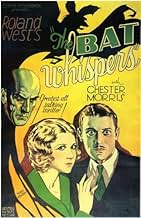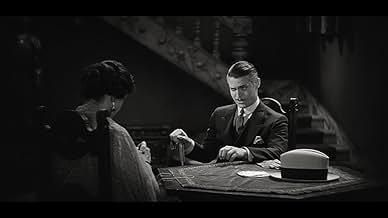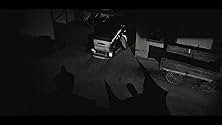IMDb-BEWERTUNG
6,3/10
1352
IHRE BEWERTUNG
Füge eine Handlung in deiner Sprache hinzuA master criminal terrorizes the occupants of an isolated country mansion.A master criminal terrorizes the occupants of an isolated country mansion.A master criminal terrorizes the occupants of an isolated country mansion.
- Regie
- Drehbuch
- Hauptbesetzung
- Auszeichnungen
- 2 wins total
Empfohlene Bewertungen
This is a great old black and white mystery/suspenser. If you have the capacity to enjoy films of the 30's and 40's and you like mysteries and fine film craftsmanship, see his movie. Chester Morris is very good as the lead. The plot is relatively true to the Hopwood/Rinehart original screenplay. The setting is an old mansion with a spinster and family members terrified by a super criminal known as the Bat. They get outside help, but the Bat strikes anyway. Who is the Bat? What does he want in the old mansion? The story answers those questions in a most old-fashioned, entertaining manner. Of the three movie versions of the Bat, the 1926 silent, the 1950's Vincent Price/Agnes Moorhead version, and this one, this is the best.
No doubt about it, the silent screen acting technique is still present in this early talkie. Everyone behaves as though they had a case of first night stage jitters--and the supposedly comic moments are painfully obvious and tainted with smokehouse ham.
But aside from the theatrics of some of the cast, this is an entertaining and truly spooky old dark house kind of comedy-mystery that was so popular during the '30s and '40s. What is most amazing is the fluidity of the camerawork through the innovative use of miniatures and the camera's ability to zoom forward and slink along the exteriors of an old mansion like a prowling cat. It is worth seeing alone for the atmospheric sets and photography, especially considering that this was filmed in 1930 when sound itself was only two years old.
Only Chester Morris among the performers delivers a really credible performance acceptable by today's standards of acting. The others are way over the top--including Una Merkel and just about all of the supporting players with the exception of William Bakewell.
If you're a fan of Mary Roberts Rinehart stories, you'll enjoy this version of her successful play. It's far superior to the later remake with Vincent Price. Be sure to see this in the newly released Wide Screen Version. It's a pristine transfer from the restoration by the UCLA Film and Television Archive.
But aside from the theatrics of some of the cast, this is an entertaining and truly spooky old dark house kind of comedy-mystery that was so popular during the '30s and '40s. What is most amazing is the fluidity of the camerawork through the innovative use of miniatures and the camera's ability to zoom forward and slink along the exteriors of an old mansion like a prowling cat. It is worth seeing alone for the atmospheric sets and photography, especially considering that this was filmed in 1930 when sound itself was only two years old.
Only Chester Morris among the performers delivers a really credible performance acceptable by today's standards of acting. The others are way over the top--including Una Merkel and just about all of the supporting players with the exception of William Bakewell.
If you're a fan of Mary Roberts Rinehart stories, you'll enjoy this version of her successful play. It's far superior to the later remake with Vincent Price. Be sure to see this in the newly released Wide Screen Version. It's a pristine transfer from the restoration by the UCLA Film and Television Archive.
Roland West first filmed the story of the Bat, a killer that steals money and jewels for their value as well as for adventure, in 1926. He then made The Bat Whispers in 1930, which is a sound version of his silent film. The transition is not entirely smooth yet rewarding. Let me first state that the silent film is easily the superior of the two. The silent film had a much more creepier feeling to it. The acting was far superior, and the sets were incredible. West does duplicate much of the sets and shots that were in his first version. The acting, however, is not very good as it is obvious that sound pictures have not been around too long. West tries to accommodate that new innovation which sometimes results in stagey scenes and long dialogue sessions. Chester Morris is...well, to say the least...a ham. His performance is a bit over-the-top for me. He does show glimmers of talent though. The story is pretty much the same and that is the film's strength. It's a fun mystery that by today's standards will seem crude and silly, but taken in context of its time should provide some entertainment. Oddly enough, the mystery seemed less mysterious in this version. I knew who the killer was with ease(trying to distance myself from the memory of the first film as I did this). West again has some impressive camera shots. The opening scene of the bat stealing a jewel from an apartment high in the sky was incredible as was the journey of the bat over a bank and following a man with a lot of money. The camera work of West is innovative, and it is a pity that his life was cut short and we did not get a chance to see him employ his talents in other projects.
I've watched the 1926, 1930 and 1930 wide screen versions many times over the years. However, the other day I finally watched the widescreen on my 5x6 foot screen which I usually save for 3D and football. The details really jumped out. There are so many wonderful camera tricks, many of which I cannot explain. As a professional modeler I can say that the miniatures were far ahead of their time, as was the skill in photographing them. They probably were only exceeded beginning with the Star Wars attack on the death star.
The fluidity of the camera was amazing for its time. The old lady and the maid walk down a long corridor, talking all the time as the camera moves ahead of them. They walk into a room and sit at a table which was right in the path of the camera. Later in the film a character vaults over a 3 foot wall and runs down a path with the camera following him, apparently right through the wall. The shadows of the Bat as he hulks on the floor are inhuman. On several startling occasions the characters jump right into the camera. These and more have been mastered for years but this film discovered them. If you are familiar with the climax of The Alibi, you remember the special effect that seemed almost real, not surpassed until CGI. The Bat Whispers is filled with such effects.
Yes, the film is static, despite all the goings on. And the acting, although unacceptable by 1932 standards was about average for 1930. However, I would gladly have strangled Maude Eburn who ruined every scene she was in. The Bat Whispers is really a guilty pleasure for modelers, cinematographers and horror fans.
The fluidity of the camera was amazing for its time. The old lady and the maid walk down a long corridor, talking all the time as the camera moves ahead of them. They walk into a room and sit at a table which was right in the path of the camera. Later in the film a character vaults over a 3 foot wall and runs down a path with the camera following him, apparently right through the wall. The shadows of the Bat as he hulks on the floor are inhuman. On several startling occasions the characters jump right into the camera. These and more have been mastered for years but this film discovered them. If you are familiar with the climax of The Alibi, you remember the special effect that seemed almost real, not surpassed until CGI. The Bat Whispers is filled with such effects.
Yes, the film is static, despite all the goings on. And the acting, although unacceptable by 1932 standards was about average for 1930. However, I would gladly have strangled Maude Eburn who ruined every scene she was in. The Bat Whispers is really a guilty pleasure for modelers, cinematographers and horror fans.
A tour-de-force of chases, shootouts, and robbery, as "The Bat" terrorizes a city, and particularly the renters of a mansion where he makes his hideout. Nearly everybody is a suspect, but the key lighting pretty much gives it away. Nonetheless, West keeps the pace moving so fast that we don't really have time to stop and think about much of anything. Features West's trademark effects with miniatures and wires.
Some remarkable photography (in 65mm, no less) in the disappearing silent gothic tradition makes this movie a link from the newly emerging horror scene to the old "haunted house with criminals" genre into which it more properly falls.
"Goofy gothic" excellence.
Some remarkable photography (in 65mm, no less) in the disappearing silent gothic tradition makes this movie a link from the newly emerging horror scene to the old "haunted house with criminals" genre into which it more properly falls.
"Goofy gothic" excellence.
Wusstest du schon
- WissenswertesOne of only a handful of films to be shot in the widescreen Magnifilm 65mm format (other studios were also experimenting with other wide formats at the time). The expense of upgrading theaters with new screens and projectors - after just having to install sound equipment - coupled with the Depression and the December 1930 edict from the MPPDA that the film industry not cause "the public's curiosity to be aroused about any new innovations for at least two years" effectively killed the new format. Widescreen formats did not return until the middle of the 1950s out of the necessity to compete with television.
- PatzerAfter the bank robbery, there is a obvious slot in the "road" where the miniature car travels.
- Zitate
The Unknown: What I'd like to know is how did you get the dope from headquarters on this case?
Detective Anderson: The same way I get everything, with my mind. I've got the greatest brain that ever existed.
- Crazy CreditsAfter the film an actor comes onto a movie house stage and implores the audience to withhold the identity of the bat from family and friends so they can also enjoy the movie.
- Alternative VersionenThis film was shot in two versions with a different director of photography for each. One is in standard 35mm and the other in an early 65mm process. The 65mm version is considered "stagebound" (it was actually based on a popular play) while the 35mm version is considered more "cinematic". Prints of both versions still exist.
- VerbindungenFeatured in Cinemassacre Video: Bat-a-Thon (2008)
Top-Auswahl
Melde dich zum Bewerten an und greife auf die Watchlist für personalisierte Empfehlungen zu.
- How long is The Bat Whispers?Powered by Alexa
Details
- Erscheinungsdatum
- Herkunftsland
- Sprache
- Auch bekannt als
- Roland West's The Bat Whispers
- Produktionsfirma
- Weitere beteiligte Unternehmen bei IMDbPro anzeigen
- Laufzeit1 Stunde 24 Minuten
- Farbe
- Sound-Mix
Zu dieser Seite beitragen
Bearbeitung vorschlagen oder fehlenden Inhalt hinzufügen
































